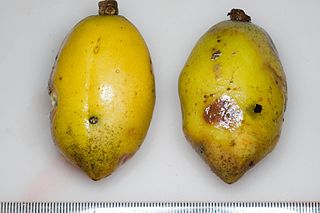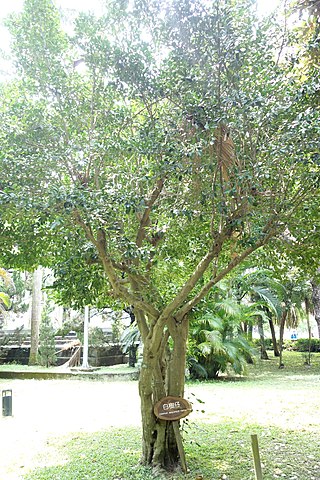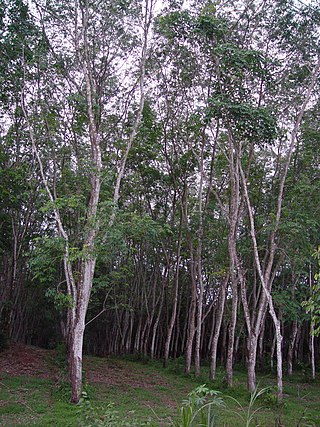
Phyllanthaceae is a family of flowering plants in the eudicot order Malpighiales. It is most closely related to the family Picrodendraceae.

The family Pandaceae consists of three genera that were formerly recognized in the Euphorbiaceae. Those are:

The Acalyphoideae are a subfamily within the family Euphorbiaceae with 116 genera in 20 tribes.

The Crotonoideae (crotonoids) is a subfamily within the family Euphorbiaceae. This subfamily contains many plants with purgative properties, such as Croton tiglium and Jatropha curcas.

Adenoclineae is a tribe of the subfamily Crotonoideae, under the family Euphorbiaceae. It comprises 2 subtribes and 6 genera.

Aleuritideae is a tribe of the subfamily Crotonoideae, under the family Euphorbiaceae. It comprises 6 subtribes and 14 genera.

Gelonieae is a dioecious flowering plant of tribe of the subfamily Crotonoideae, under the family Euphorbiaceae. It comprises 2 genera. Grows in Africa, Madagascar and in tropical Asia.

The Jatropheae are a tribe of the subfamily Crotonoideae, under the family Euphorbiaceae. It comprises eight genera.

Micrandreae is a tribe of the subfamily Crotonoideae, under the family Euphorbiaceae. It comprises 2 subtribes and 4 genera.

Ricinodendreae is a tribe of the subfamily Crotonoideae, under the family Euphorbiaceae. It comprises 3 genera.

The Agrostistachydeae is a tribe of the subfamily Acalyphoideae, under the family Euphorbiaceae. It comprises 4 genera, which are monophyletic.
Benoistia is a genus of shrubs or trees of the spurge family (Euphorbiaceae) and the monotypic subtribe Benoistiinae. It was first described as a genus in 1939. The entire genus is endemic to Madagascar. It is dioecious.
- Benoistia orientalisRadcl.-Sm. - N + E Madagascar
- Benoistia perrieriH.Perrier & Leandri - Madagascar
- Benoistia sambiranensisH.Perrier & Leandri - N Madagascar
Johanna Emilie Katharina Elizabeth "Käthe" Hoffmann was a German botanist who described many plant species in New Guinea and South East Asia including Annesijoa novoguineensis. She was a high school teacher (Mittelschulleherin) at Breslau, German Empire, and made a significant contribution to botany. In one study, she was found to have co-authored or authored 354 land plant species, the sixth-highest number authored by any female scientist. As of May 2020, Plants of the World Online lists 439 accepted genera and species which include Käthe Hoffmann in the authority, in some capacity.

Ricinocarpos is a genus of evergreen flowering plants in the family Euphorbiaceae and is endemic to Australia. Plants in the genus Ricinocarpos are monoecious shrubs with leaves arranged alternately along the branches, the edges curved downwards or rolled under. Male flowers are arranged singly or in racemes at the ends of branchlets, with four to six sepals that are fused at the base. There are four to six petals that are longer than the sepals, with many stamens fused to form a central column. Female flowers are arranged singly and are similar to male flowers but with three styles fused at the base and with a deeply branched tip. The fruit is a capsule containing seeds with an elaiosome.

Euphorbiaceae, the spurge family, is a large family of flowering plants. In English, they are also commonly called euphorbias, which is also the name of the type genus of the family. Most spurges, such as Euphorbia paralias, are herbs, but some, especially in the tropics, are shrubs or trees, such as Hevea brasiliensis. Some, such as Euphorbia canariensis, are succulent and resemble cacti because of convergent evolution. This family has a cosmopolitan global distribution. The greatest diversity of species is in the tropics; however, the Euphorbiaceae also have many species in nontropical areas of all continents except Antarctica.
Plukenetia conophora, also called Nigerian walnut, and conophore, is a climbing shrub in the genus Plukenetia. It is not related to the walnut, being so named because its nuts bear a superficial resemblance to the walnut. It is native to tropical western and central Africa from Togo to Congo and in Sierra Leone. It is abundant in the Nigeria, Cameroon, Republic of the Congo and Democratic Republic of Congo. It prefers rain-forest hedge in half-shady places; low bush; secondary forest; plantations at elevations from 250–1,400 m (820–4,590 ft). Although it is well recorded in Sierra Leone, it is apparently not indigenous to Sierra Leone, since it is not recorded in Liberia and Ghana. Its presence in Sierra Leone is due to returning slaves for it is known to the Krio by its Yoruba (Nigerian) name. Plukenetia conophora is the only Plukenetia species native to West Africa or Central Africa. Other Plukenetia species are indigenous to other parts of Africa, the Indian Subcontinent, Southeast Asia, and America.
Manihot pulchriforius is a flowering shrub that ranges from 1–2.5 metres tall and produces deep red or purple flowers, as well as dark green fruit with purple wings. It grows in the preserved mountains of Serra Dourada, in the state of Goiás, Brazil, and is commonly found growing on rocky outcrops 900–1,000 m (3,000–3,300 ft) in elevation.

Beyeria lechenaultii is a species of dioecious flowering plant in the spurge family, Euphorbiaceae, that is endemic to Australia.














